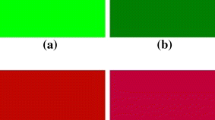Abstract
Studies on color quantization have indicated that its applications range from the relaxation of displaying hardware constraints in early years to a modern usage of facilitating content-based image retrieval tasks. Among many alternatives, approaches based on neural network models are generally accepted to be very effective in color quantization. However, the inefficiency prevents their usefulness from practical usage. In view of this, we thus propose to incorporate a growing quadtree structure to the self-organizing map (GQSOM) technique in this work. Specifically, the strategy of inheriting from parent neurons hierarchically facilitates a much more efficient and flexible learning process. Both theoretical and empirical studies show that our approach is adaptive in determining an appropriate number of quantized colors. Moreover, the efficiency is significantly improved without compromise of the effectiveness.
Preview
Unable to display preview. Download preview PDF.
Similar content being viewed by others
References
Atsalakis, A., Papamarkos, N.: Color Reduction and Estimation of the Number of Dominant Colors by Using a Self-Growing and Self-Organized Neural Gas. Engineering Applications of Artificial Intelligence 19(7), 769–786 (2006)
Chang, C.-H., Xu, P., Xiao, R., Srikanthan, T.: New Adaptive Color Quantization Method Based on Self-Organizing Maps. IEEE Transactions on Neural Networks 16(1), 237–249 (2005)
Chang, Y.-C., Lee, D.-J.: Color Image Quantization Using Color Variation Measure. In: Proceedings of the IEEE Symposium on Computational Intelligence in Image and Signal Processing, April 2007, pp. 127–132 (2007)
Dekker, A.: Kohonen Neural Networks for Optimal Colour Quantization. Network: Computation in Neural Systems 5(3), 351–367 (1994)
Gonzalez, R.C., Woods, R.E.: Digital Image Processing, 2nd edn. Pearson Prentice Hall (2007)
Heckbert, P.: Color Image Quantization for Frame Buffer Display. ACM SIGGRAPH Computer Graphics 16(3), 297–307 (1982)
Imagemagick, http://www.imagemagick.org/
Kirk, J.S., Chang, D.-J., Zurada, J.M.: A Self-Organizing Map with Dynamic Architecture for Efficient Color Quantization. In: Proceedings of the International Joint Conference on Neural Networks, July 2001, pp. 2128–2132 (2001)
Kohonen, T.: The Self-Organizing Map. Proceedings of the IEEE 78(9), 1464–1480 (1990)
Koikkalainnen, P.: Progress with the Tree-Structured Self-Organizing Map. In: Proceedings of the 11th European Conference on Artificial Intelligence, August 1994, pp. 211–215 (1994)
Martin, D., Fowlkes, C., Tal, D., Malik, J.: A Database of Human Segmented Natural Images and Its Application to Evaluating Segmentation Algorithms and Measuring Ecological Statistics. In: Proceedings of the 8th IEEE International Conference on Computer Vision, July 2001, pp. 416–423 (2001)
Papamarkos, N., Atsalakis, A.E., Strouthopoulos, C.P.: Adaptive Color Reduction. IEEE Transactions on Systems, Man, and Cybernetics 32(1), 44–56 (2002)
Wang, C.-H., Lee, C.-N., Hsieh, C.-H.: Sample-Size Adaptive Self-Organization Map for Color Images Quantization. Pattern Recognition Letters 28(13), 1616–1629 (2007)
Wong, K.-M., Po, L.-M., Cheung, K.-W.: A Compact and Efficient Color Descriptor for Image Retrieval. In: Proceedings of the 2007 IEEE International Conference on Multimedia and Expo., July 2007, pp. 611–614 (2007)
Author information
Authors and Affiliations
Editor information
Editors and Affiliations
Rights and permissions
Copyright information
© 2009 Springer-Verlag Berlin Heidelberg
About this paper
Cite this paper
Chang, PL., Teng, WG. (2009). Exploiting a Growing Self-organizing Map for Adaptive and Efficient Color Quantization. In: Muneesawang, P., Wu, F., Kumazawa, I., Roeksabutr, A., Liao, M., Tang, X. (eds) Advances in Multimedia Information Processing - PCM 2009. PCM 2009. Lecture Notes in Computer Science, vol 5879. Springer, Berlin, Heidelberg. https://doi.org/10.1007/978-3-642-10467-1_123
Download citation
DOI: https://doi.org/10.1007/978-3-642-10467-1_123
Publisher Name: Springer, Berlin, Heidelberg
Print ISBN: 978-3-642-10466-4
Online ISBN: 978-3-642-10467-1
eBook Packages: Computer ScienceComputer Science (R0)




